School Outreach Activities
While working at Raytheon (2016 to 2023+)
I have had multiple opportunities to interact with
college and high school students. This includes
mentoring and advising on Senior-Projects,
presenting technical lecturers, and running camps, workshops, and
tech demos for the students. A sampling of some of these activities
is provided here.
Texas Christian University (TCU) - Tech Demo - 2022
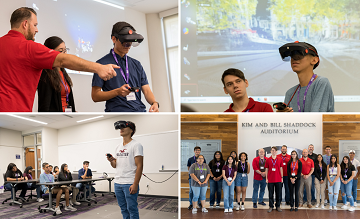
In October, 2022, Nick Castillo and I were invited to give a demo of AR technology at the
TCU Supply Chain Business Technology Camp Experience.
This was arranged by David Boelens and the
TCU faculty and staff coordinating the event
- who were really awesome to meet and work with.
Nick and I setup the demo and answered questions.
We were assisted by our interns,
Crystal Hernandez and Kendal Wiggins,
in running the demo.
The demo used Virtual Reality (VR) devices
to help students understand how technology can aid supply chain operations.
We focused the content in such a way the
students could learn about product and facility differences
between factories in a virtual environment.
This use case demonstrated how workers
can leverage VR to increase process accuracy and gain efficiencies,
while reducing costs related to travel,
workplace errors and slow process times.
Texas A&M University (TAMU) - Tech Presentation - 2020
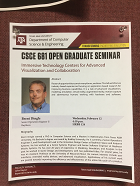
In February, 2020, I gave a presentation at Texas A&M University,
for the Computer Science and Engineering Department's CSCE 681, open
Graduate Seminar. This was an officially
approved-for-public-release presentation by Raytheon,
including foreign and non-foreign audiences.
The presentation introduced the students to some business use cases for
Immersive Design Centers including: Design for Manufacturing
and Assembly (DFMA) reviews, facility reviews, demos and customer
engagements, and 2D data reviews. It also illustrated how the use of
single-node systems as opposed to cluster-based systems provide significant
advantages such as: decreased cost, applicable to more use cases, easier
to use, more accessible to less technically oriented audiences...
The presentation included examples of projects done
by interns within the IDC. The intent was to demonstrate even iterns
can make a significant impact on a major corporation. It also
illustrated the broad range of opportunities to explore new technology
and improve business capabilities.
Feedback and summaries were given by the students to the course instructor.
Overall, the presentation was well received by the students.
University of Texas, Dallas (UTD) - Senior Capstone - 2019
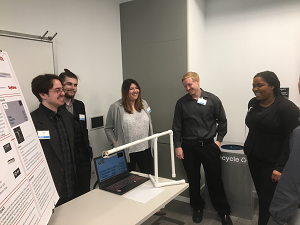
In 2019 I was a mentor for a Raytheon (Space and Airborne Systems at the time)
sponsored project. Keith Janasak and Ann Miller helped organize the business
coordination between Raytheon and UT-Dallas.
We were fortunate enough to have two teams assigned to us.
This meant I had to create two related but different problem challenges for the
two teams, and focus their activities towards solving it.
I selected the topic area for both projects to be Motion Based Tracking.
One project would focus on hand-tracking, the other would focus on body-tracking.
The first problem description went something like:
- Augmenting reality by interfacing with engineering applications through motion capture
- Department: Computer Science
- Sponsor: Raytheon Space and Airborne Systems (SAS)
- Semester: Spring 2019
- Team Name: Jazz Hands
- The purpose of our project was to design a motion capture interface that captures
hand motion, displays infrared camera footage, and skeletal hand footage. Users
are able to record motion data, pause between recording takes, stop recording,
and save their hand motion data. The motion capture interface reproduces
the motion data into a digital human modeling software, motion builder,
to display the recorded data. The motion data is converted into a
BVH file format for easy replay in other software systems.
The second problem statement was related to the first and was described something like:
- Augmenting reality by interfacing with engineering applications through motion capture – 2
- Department: Computer Science
- Sponsor: Raytheon Space and Airborne Systems (SAS)
- Semester: Spring 2019
- Team Name: Team Skelé
- The overall goal of this project was to augment reality by interfacing with
engineering applications through motion capture. Our project solution aims
to capture skeletal motion data from a camera and import or stream it into
a digital human modeling software, namely Siemens Tecnomatix Jack,
for rigging and joint stress analysis. Also provided is a graphical
interface with skeletal, depth, and RGB data feeds, and the ability to
save motion data to a file for ease of export or import to other applications.
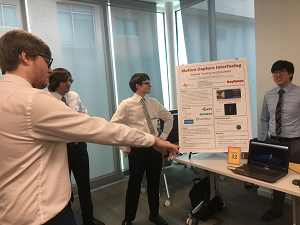
I met with the students weekly, sometimes more often, across the semester.
Both teams were significantly challenged in completing the projects.
Dr. Ryan McMahan (UTD) also provided occassional support. One of the most unexpected
findings in this work was the discovery of an error in Siemens Jack interfacing
data -- an actual bug in the software. This was reported to Siemens,
by the students (through SAS),
and they were provided a brand-new-test-build to overcome the issue.
This was remarkably supportive of Siemens, and the students were very thankful.
Siemens also expressed their thanks to the students for uncovering the issue,
and describing it in detailed well enough for it to be fixed - literally overnight.
By the end of the semester both teams had functioning code. On May 9th, UTD held a ceremony
for all the captsones projects. Every capstone team had to present their projects.
Each was judged by outside corporate participants
and awards were given to the winning projects. While neither of our teams
won, it was a very enjoyable and educational
experience for the students. I was honored to be involved.
Reference to the projects can be found on the UT-Dallas website:
Past Senior Capstone Projects
Searching on sponsor: Raytheon Space and Airborne Systems, should return the above
two projects and maybe a third, all done during Spring 2019. The small pictures
shown here should link to a larger, more readable image.
These are photos of the posters on display at the UTD public event.
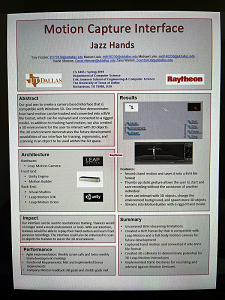
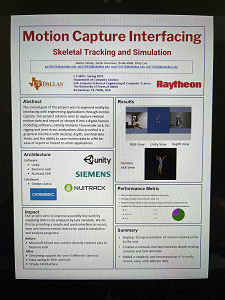
University of Arizona (UA) - Senior Project - 2017
Smart Work Environment and Application of Augmented Reality Overlay for Manufacturing
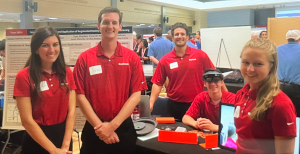
For 2016-2017 school year I was a mentor for a Raytheon (Raytheon Missile Systems at the time)
sponsored project. Bryan Bergsma was the lead point of contact and
worked many of the coordination details between Raytheon and the University,
along with Sharon O'Neal.
For this project the students were required to use Augmented Reality (AR)
to assist factory workers in assembling a cubesat satellite. Among other roles,
I was the lead advisor for helping them write code for the HoloLens. I met with
them at least once every month, often more frequently. This was a year long
project ending in May with the
Design Day Presentations and Awards
This experience
includes all the business aspects as well as the technical development. So the
team had to conduct required gate review meetings. These include
such things as a Product Design Review (PDR) and a Customer Design Review (CDR).
As a mentor I atteneded these meetings under the role of customer.
However, in the background, I also helped them prepare for these meetings
- not directly in content, but in structure, flow, and expectations.
It was an excellent learning experience for all.
This team of students was a lot of fun to interact and work with.
For the most part they did really well, and I believe they learned
a great deal about running a project through all its phases.
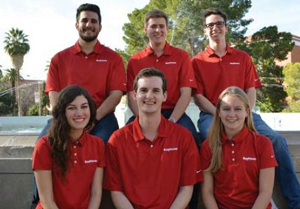
The details of this project can be found on UA's website:
Project 16011
Smart Work Environment and Application of Augmented Reality Overlay for Manufacturing.
You might also be able to
perform a search
for the 2016-2017 academic year. And at one point in time it was in the online
UA Engineering Design Day Book 2017.
The official project description went something like:
The goal of this project was to investigate opportunities to increase
efficiency by implementing Industry 4.0 smart factory OSC technology,
which centers on automation and data exchange, into the sponsor's
manufacturing facilities. The project also uses augmented reality,
in the form of Microsoft HoloLens technology, to further improve
manufacturing capabilities. The sponsor's factory workers and
engineers will be able to use the augmented reality system to view
visually guided instructions for the assembly and manufacture of
small satellites. The team also produced a trade study for the
sponsor that analyzes Industry 4.0 and smart factory OSC technology
factors of interest to the sponsor, such as equipment cost
and training time.







